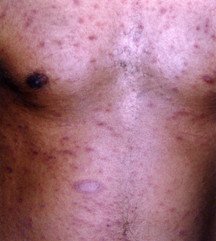Pityriasis rosea
Medically reviewed by Drugs.com. Last updated on Dec 4, 2023.
What is Pityriasis rosea?

Pityriasis rosea is a harmless skin disease that causes scaly patches that sometimes itch over the torso, neck, arms and legs. Anyone can get it, but it is most common in people ages 10 to 35.
Typically, the disease begins with the appearance of a single large, pink, scaly, oval patch, called the "herald patch." This patch is approximately 1 inch to 2 inches long. It tends to have a salmon-colored center surrounded by a darker pink ring, which some people mistake as a sign of ringworm.
|
|
Within about two weeks, many smaller patches appear, sometimes hundreds of them. They appear mainly on the abdomen and back. On the back, the patches tend to line up along the ribs, giving the rash a distinct "Christmas tree" pattern. The rash goes away on its own, usually within two months. Any skin discoloration from the rash will fade after another few months.
The exact cause of pityriasis rosea is unknown. There is some evidence to suggest it is caused by a reactivation of human herpesvirus 7 (HHV-7). It seems to occur most often in spring and autumn. It is not thought to be contagious, and it does not lead to any other disorder.
Symptoms
The main symptoms of pityriasis rosea are the appearance of the herald patch followed by a more diffuse rash of smaller patches. The patches tend to be oval, scaly, and dry to the touch. They may be pink, red or brown and generally appear on the abdomen, back, neck, arms and legs. Only rarely do the patches appear on the face.
Usually there are no other symptoms. However, some people experience itching that can be intense.
Diagnosis
In most cases, a physician or dermatologist can diagnose pityriasis rosea simply by looking at it. Although there is no specific blood test to diagnose pityriasis, blood testing may be ordered to exclude other diagnoses. If there is any question of a skin fungus, a scraping of the edge of a spot will be placed on a slide and examined under the microscope. Rarely, a skin biopsy is needed to confirm the diagnosis. In a biopsy, a small piece of tissue is removed and sent to a laboratory to be examined.
Expected duration
After the initial rash, or herald patch, appears, the secondary rash of smaller patches appears within about 2 to 14 days. This more widespread rash generally lasts 3 to 8 weeks but may linger for months.
Prevention
Because no one knows what causes pityriasis rosea, there is no way to prevent it. It does not appear to be contagious.
Treatment
Itching, if present, can be treated in several ways. An over-the-counter a lotion that cools the skin (such as one with camphor or menthol) or corticosteroid cream (such as Cortizone-10 or Cortaid) may be enough to provide relief. For more severe itching, your doctor may advise an oral antihistamine or prescribe a stronger corticosteroid cream.
In very severe cases, or if the rash lasts longer than usual or the rash covers a large part of the body, ultraviolet (UV) light therapy may be recommended. Doses of UV-B rays, similar to the sun's rays, are given by exposing the skin to the light rays for short periods of time over several days. The skin may turn slightly red, similar to a mild sunburn.
Also, there is some evidence that oral acyclovir might shorten the duration of the rash.
The red spots may appear more prominently after a hot shower or bath and after heavy physical activity. The condition doesn't get worse. The rash simply becomes more noticeable.
When to call a professional
See a health care professional if you or your child develops an unexplained rash. Although treatment is not necessary for pityriasis rosea, its symptoms are similar to other skin diseases, such as ringworm, that need to be treated. Your physician can diagnose the problem and recommend appropriate treatment.
Prognosis
The outlook is excellent. Most cases clear up within two months. The rash rarely returns. Although some people, especially those with dark skin, experience some skin discoloration from the rash spots, it usually fades with time. Generally, there are no lasting effects.
Additional info
American Academy of Dermatology
https://www.aad.org/
Further information
Always consult your healthcare provider to ensure the information displayed on this page applies to your personal circumstances.

